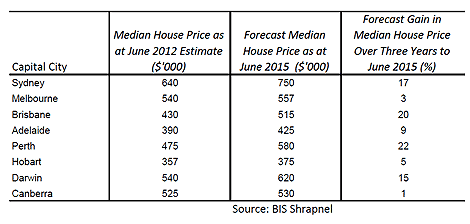Melbourne residential property market to struggle as ‘stars align’ for Sydney and resources states: BIS Shrapnel
The “stars are beginning to align” for the Sydney residential housing market, with median prices forecast to grow by a cumulative 17% over the next three year to reach a median of $750,000, according to a new report by BIS Shrapnel.
Sydney, Perth, Brisbane and Darwin house prices are expected to grow by at least 5% per year between now and 2015, while the “non-resource state” housing markets will continue struggle.
In percentage growth terms, Perth is expected to record the strongest capital growth appreciation over this period with its median house prices climbing 22% from $475,000 to $580,000 – more than 7% per year.
BIS Shrapnel also has strong growth expectations for Brisbane (20% rise to $515,000) and Darwin (15% to $620,000) but the outlook is poor for Melbourne, with house prices expected to rise just 3% to $557,000 by 2015.

According to BIS Shrapnel senior manager Angie Zigomanis, author of the Residential Property Prospects, 2012 to 2015 report, a continued shortfall in new dwelling construction in Sydney to meet population growth will mean that rental growth will remain solid in the next two to three years.
“This deficiency will eventually encourage investors back into the Sydney market.
“Once there is evidence that prices have bottomed out and sentiment improves, the return of price growth will in turn promote further investor demand. After showing signs of a turnaround in 2012-13, price growth should pick up in 2013-14,” Zigomanis says.
BIS Shrapnel says the Perth market recovery will be driven by significantly improving affordability and accelerating population growth.
“Population growth is already accelerating as Perth also benefits from rising overseas and interstate migration and, combined with recent weak new dwelling construction, has resulted in vacancy rates tightening from 3.5% at June 2011, to 1.9% in March 2012.”
“With unemployment in the state already leading the nation at 3.8% in March 2012 and economic and income growth to continue to strengthen, the first stages of a turnaround should appear in 2012-13 before stronger price growth emerges in 2013-14 and 2014-15 as economic growth approaches a peak.”
Brisbane’s predicted strong house price growth is based on rental growth recovery (as vacancies tighten below 3%), improving affordability, recent interest rate reductions and a projected recovery in the state’s economy.
“Consequently, economic conditions are forecast to rapidly improve, with the ensuing employment and income growth to create a greater level of purchaser confidence,” says Zigomanis.
In contrast conditions are expected to remain tough in the non-resource states of Victoria, South Australia, Tasmania and ACT.
“These states all had the strongest bounce in construction after the global financial crisis, with the result being an erosion of their dwelling deficiency and/or an emerging excess of dwelling stock,” says BIS Shrapnel.
Melbourne faces headwinds from a subdued state economic environment in 2011-12 that has placed downward pressure on prices.
“With Melbourne’s dwelling deficiency being eroded, there is little upward pressure on prices,” says Zigomanis.
“We anticipate that prices will stabilise in 2012-13 due to the impact of lower interest rates and an improving outlook for the national economy. However, there will be little to support price growth in the city over the next three years and conditions will continue to remain tough,” he says.
“Non-resource states” will also face headwinds from underperforming economies.
“Economically, these states are also underperforming due to a fall-off in construction and a negative impact to industry from the high Australian dollar,” says Zigomanis.
“The improvement in affordability from lower interest rates may stabilise house prices in this environment.
“However, without any supply pressures, median house prices in Melbourne, Adelaide, Hobart and Canberra are forecast to show little change and decline in real terms over the next three years,” he says.
